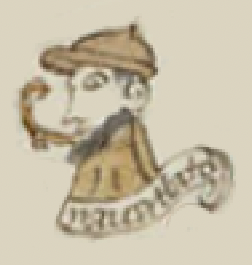nahuatlato (CST15)
This painting of the simplex glyph for the term nahuatlato (interpreter) shows the upper body and head of a man in profile, facing toward the viewer’s left. He wears a brown cap and coat, and there is a black beard on his chin. A speech scroll emerges from his mouth, which conveys that he is speaking (tlatoa, or tlahtoa, with the glottal stop). These suggest he may be a Spaniard or a Hispanized Nahua. His name is not given. He is shown with a notary; the two of them received a total of twenty pesos in pay for the work they did during their visit from Mexico City.
Stephanie Wood
This image has been extracted from a string of such figures, where each figure has an identifying banderole. We were somewhat tempted to call this an example of iconography and not a glyph, but it does not come from a full, painted “scene” in the European sense. The figures float somewhat, have partial bodies, and are shown in profile. For more on the Codex Sierra, see Kevin Terraciano’s study (2021), especially p. 37, Fig. 3.6.
Stephanie Wood
1550–1564
Jeff Haskett-Wood
interpretes, barbillas, gorras, oficios

nahuatlato, a speaker of Nahuatl who worked as an interpreter, https://nahuatl.wired-humanities.org/content/nahuatlato
tlatoa, to speak, https://nahuatl.wired-humanities.org/content/tlatoa-0
nahua(tl), the Nahuatl language or something that makes a pleasant sound, https://nahuatl.wired-humanities.org/content/nahuatl
nahuatlato, interprete
Stephanie Wood
Códice Sierra-Texupan, plate 15, page dated 1555. Origin: Santa Catalina Texupan, Mixteca Alta, State of Oaxaca. Kevin Terraciano has published an outstanding study of this manuscript (Codex Sierra, 2021), and in his book he refers to alphabetic and “pictorial” writing, not hieroglyphic writing. We are still counting some of the imagery from this source as hieroglyphic writing, but we are also including examples of “iconography” where the images verge on European style illustrations or scenes showing activities. We have this iconography category so that such images can be fruitfully compared with hieroglyphs. Hieroglyphic writing was evolving as a result of the influence of European illustrations, and even alphabetic writing impacted it.
https://bidilaf.buap.mx/objeto.xql?id=48281&busqueda=Texupan&action=sear...
The Biblioteca Digital Lafragua of the Biblioteca Histórica José María Lafragua in Puebla, Mexico, publishes this Códice Sierra-Texupan, 1550–1564 (62pp., 30.7 x 21.8 cm.), referring to it as being in the “Public Domain.” This image is published here under a Creative Commons license, asking that you cite the Biblioteca Digital Lafragua and this Visual Lexicon of Aztec Hieroglyphs.


